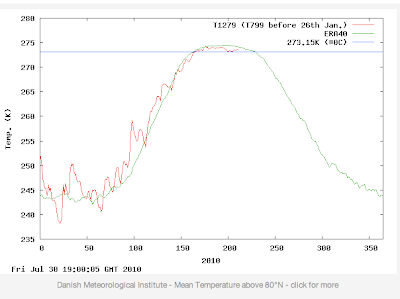More on Soot Causing the Arctic Ice Melt
On December 5, 2009, I wrote this post demonstrating that it is soot, not 'global warming' (or any warming for that matter) that has caused the recent ice melt in the Arctic.
The scientific evidence continues to build demonstrating that soot is indeed the problem.
Hat tip: Watts Up With That.
There is an important point here: We need to correctly assign causes and effects. We can reduce carbon dioxide all we want and it will make no difference if the problem is soot.
UPDATE: Here is a graph of Arctic temperatures from the Danish Meteorological Institute with data as of yesterday to clarify the point of this posting and the comment from Van, below. The red line is the temperature. The green line is the "normal" temperature and the blue line is the melting point of ice (273°K = 32°F). Temperatures this summer are well below normal but ice is less than normal. The reason is soot melting the ice as indicated above.
The scientific evidence continues to build demonstrating that soot is indeed the problem.
Hat tip: Watts Up With That.
There is an important point here: We need to correctly assign causes and effects. We can reduce carbon dioxide all we want and it will make no difference if the problem is soot.
UPDATE: Here is a graph of Arctic temperatures from the Danish Meteorological Institute with data as of yesterday to clarify the point of this posting and the comment from Van, below. The red line is the temperature. The green line is the "normal" temperature and the blue line is the melting point of ice (273°K = 32°F). Temperatures this summer are well below normal but ice is less than normal. The reason is soot melting the ice as indicated above.





I just read your "scientific evidence" demonstrating that soot is causing melting, except that isn't what the study said. It states clearly that "black soot is contributing to global warming." i.e. black soot is another adding to the warming caused by CO2 and needs to be added to models to correctly predict future climate change. This doesn't reduce the evidence for global climate change caused by humans, it INCREASES it.
ReplyDeleteYou are right, we need to correctly assign causes and effects. The latest studies indicate that we need to assign a warming role to black carbon that has hitherto been unaccounted for. You should also understand that soot and CO2 are generated together and reducing one reduces the other.
Van,
ReplyDeleteI was specifically writing about the shrinkage of polar ice in recent years that has been in the news, in spite of temperatures being below normal in the Arctic in the melt season. It was not a post about the larger issue of global warming.
At the surface, black carbon would, and does, increase warming -- other factors equal. It is less certain how carbon affects temperature when it is aloft and being transported by winds.
Atmospheric science knows relatively little about how soot, tiny particles called aerosols, and clouds affect the heat and radiation budget of the earth. These are huge uncertainties in the larger global warming issue.
I take issue that one can equate CO2 and soot. Soot absorbs short wave radiation, CO2 effects outgoing long wave radiation. It is unlikely there is a 1:1 correspondence.
Thank you for your comment.
Mike